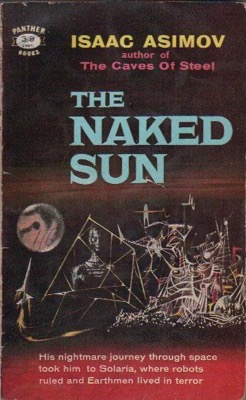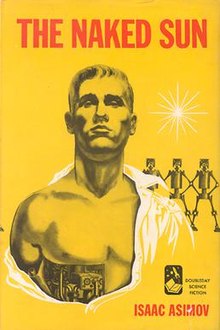A defining quality of good fiction, and especially good science fiction, is that it makes the familiar strange and the strange familiar. Detective fiction goes a bit further by seeking to make significant that which is (seemingly) ordinary and to make clear that which is (temporarily) opaque. Asimov, in this sequel to another futuristic detective novel (Caves of Steel), expertly combines those feats of literary alchemy into a lively, thought-provoking entertainment.
 Many centuries hence, a murder occurs on the Outer Worlds planet of Solaria, where crime is practically nonexistent—and so is any kind of police force. Peculiar facts about the killing raise the need for a serious inquiry. Whoever killed Rikaine Delmarre bludgeoned him at close range, but no weapon turned up in the initial search of the crime scene. Evidence supplied by robots establishes that the only other human near that scene was the victim’s wife, Gladia, yet she fell unconscious around the time of the murder and had no chance to dispose of a weapon. Faced with this quandary, the Solarian powers-that-be deign to invite a mere Earthman to work the case on their behalf. Elijah Baley, a “plainclothesman” from New York City, thus finds himself traveling millions of miles to a planet known for its “naked sun.” (In the Earth of this imagined future, people live in subterranean “caves of steel” and have no direct experience of the star that lights their galaxy.) There, Baley reunites with Daneel Olivaw, a “positronic” robot who served as his sidekick in the previous adventure. Soon after Baley and Olivaw begin their probe, someone attempts a second murder. As the two detectives communicate via holographic projection with Hannis Gruer, the planet’s head of security, they watch him suddenly lurch into convulsions after sipping from a glass of water. Clearly, the glass contains poison. But who could have administered it, and how? Like other Solarians, Gruer lives alone on a vast estate; only his robots are able to come anywhere near him, and robots are hard-wired to avoid causing harm to their human masters.
Many centuries hence, a murder occurs on the Outer Worlds planet of Solaria, where crime is practically nonexistent—and so is any kind of police force. Peculiar facts about the killing raise the need for a serious inquiry. Whoever killed Rikaine Delmarre bludgeoned him at close range, but no weapon turned up in the initial search of the crime scene. Evidence supplied by robots establishes that the only other human near that scene was the victim’s wife, Gladia, yet she fell unconscious around the time of the murder and had no chance to dispose of a weapon. Faced with this quandary, the Solarian powers-that-be deign to invite a mere Earthman to work the case on their behalf. Elijah Baley, a “plainclothesman” from New York City, thus finds himself traveling millions of miles to a planet known for its “naked sun.” (In the Earth of this imagined future, people live in subterranean “caves of steel” and have no direct experience of the star that lights their galaxy.) There, Baley reunites with Daneel Olivaw, a “positronic” robot who served as his sidekick in the previous adventure. Soon after Baley and Olivaw begin their probe, someone attempts a second murder. As the two detectives communicate via holographic projection with Hannis Gruer, the planet’s head of security, they watch him suddenly lurch into convulsions after sipping from a glass of water. Clearly, the glass contains poison. But who could have administered it, and how? Like other Solarians, Gruer lives alone on a vast estate; only his robots are able to come anywhere near him, and robots are hard-wired to avoid causing harm to their human masters.
To read this book during the 2020–2021 pandemic is to experience a shock of recognition—a glimpse of the present as foreshadowed by a decades-old vision of the future. The people of Solaria, like those of plague-scarred Earth in the time of Covid-19, interact with other humans almost entirely by remote means. Asimov posits a technology that enables what Solarians call “viewing,” and his descriptions of that practice suggest a three-dimensional version of the screen-mediated forms of engagement (Zoom meetings and the like) on which people today increasingly depend. Solarians, who descend from human Earthlings, differ from present-day humans in that they prefer viewing to its in-person alternative, which they call “seeing.” In effect, Solarians have replaced the need for human contact with a reliance on legions of supremely advanced robots. That feature rings a contemporary bell, too. Denizens of Earth do not have high-functioning anthropomorphic machines to assist them during long months of pandemic isolation. But, like their counterparts on Solaria, they struggle to understand and manage the devices (smart and not-so-smart) that they have made.
The peculiar conditions of Solaria are a critical factor in the crimes of apparent impossibility that Baley must solve. These puzzles, in fact, are keenly satisfying because they arise from—and hinge on—those very conditions. Each actual or attempted murder appears to lie outside the realm of the possible because (and only because) it takes place amid a cluster of social customs and logistical circumstances that are unique to the world that Asimov has constructed. For example, the visceral aversion that Solarians (most of them, anyway) have to sharing physical space with other humans creates a situation in which the killing of Delmarre and the attack on Gruer seem to defy explanation. Likewise, the Three Laws of Robotics, which are part of a system that Asimov has built into this world, set precise limits on the kinds of violence that robots can either perpetrate or allow to happen in their vicinity. To crack the mysteries at hand, Baley must tease apart the implications of these and other features of Solarian civilization.
Asimov manages the mystery plot with high professionalism, and he deals competently with adult themes that involve matters of human intimacy and human destiny. Even so, Naked Sun displays traces of a juvenile sensibility that was fairly common in mid-20th-century science-fiction writing.  Too often, a gee-whiz tone overtakes Asimov’s otherwise serviceable prose, and his lead character, Baley, comes across as an earnest, boringly upright fellow—less as an heir to Philip Marlowe than as a law-enforcement version of Buck Rogers. In addition, there is a subplot that concerns the threat of intergalactic war, and although Asimov handles that story line with some complexity, its presence here brings a pulpy space-opera element into what should be (and mostly is) a tightly focused tale of investigation and discovery.
Too often, a gee-whiz tone overtakes Asimov’s otherwise serviceable prose, and his lead character, Baley, comes across as an earnest, boringly upright fellow—less as an heir to Philip Marlowe than as a law-enforcement version of Buck Rogers. In addition, there is a subplot that concerns the threat of intergalactic war, and although Asimov handles that story line with some complexity, its presence here brings a pulpy space-opera element into what should be (and mostly is) a tightly focused tale of investigation and discovery.
Like the best science fiction of its era, the novel also explores big ideas in a big, none-too subtle way. As the tale unfolds, Asimov presents a series of conversations between the Earthman sleuth and several of the Solarian suspects, including a sociologist, a roboticist, and the erstwhile assistant of the first victim, who had been the planet’s foremost “fetal engineer.” These conversations teem with anxious speculations about parenthood and family life, about population growth and the fate of nations (or, indeed, of entire planets), about humanoid machines and the humans who create them—preoccupations that were bubbling just under the surface of American culture during the 1950s. To reach Solaria, Baley spans many lightyears in a space capsule. Asimov, meanwhile, brings something else back from his fictive journey: a time capsule.
[ADDENDUM: A recent column in The New York Times by Paul Krugman spurred me to read this book at this time. Krugman flags the somewhat uncanny way that Asimov prefigured life under semi-lockdown. Naked Sun features “a society in which people live on isolated estates, their needs provided by robots and they interact only by video,” the columnist writes. “The plot hinges on the way this lack of face-to-face contact stunts and warps their personalities.”
So my review here steals just a bit from Krugman. It also steals a bit from myself. Looking back at my piece on the prequel book, Caves of Steel, I see that that I’ve touched on some of the same themes again—the science-fiction-as-time-capsule idea, the motif of using futuristic conditions (such as “laws” that govern robot behavior) to drive an impossible-crime plot. So I’m less original in this instance than I could be. Then again, the same is true of Asimov.]
Steve Powell
April 2, 2021 at 11:33 AM
Brilliant piece. Welcome back.
James Lawther
May 16, 2021 at 6:44 AM
I think the problem with many science/crime fiction crossovers is that they can’t resist the temptation to become intergalactic space operas.
The obvious one that didn’t is Do androids dream of electric sheep but that left me a little cold.
Are there any you would recommend?
Mike
May 16, 2021 at 9:10 AM
Thanks for the comment, James. (I like your review site, by the way. The range of titles that you cover there roughly matches the range of my own taste in crime fiction.) I’m afraid I might have implied a greater knowledge of SF crime stories than I actually possess. I’ve only read the two Asimov books that I’ve reviewed here (“Caves of Steel” and “Naked Sun”). Both are better than they need to be, in my view. I haven’t read “Do Androids,” but I probably should try it someday, since the movie “Blade Runner” strikes me as being a very successful variation on the hardboiled crime story.
James Lawther
May 16, 2021 at 9:14 AM
TBH, I think the film was better than the book, a lot better, though I’m sure some would call me a philistine.
It has got me thinking though, I’m sure there must be something.
dfordoom
June 23, 2021 at 6:25 AM
I think James P. Hogan’s INHERIT THE STARS (from 1977) is one of the better science/crime fiction crossovers. There’s a genuine mystery to be solved and it’s genuine science fiction as well.
=Tamar
June 23, 2021 at 7:58 PM
Randall Garrett’s Lord Darcy mysteries might qualify, though they are more fantasy than SF.
Steve A Oerkfitz
June 26, 2021 at 1:42 PM
Couldn’t get through Caves of Steel. The characterizations of his wife and son are awful and the dialogue cringe worthy.
Mike
June 26, 2021 at 6:36 PM
I can’t disagree about the characterization and dialogue, which hokey, to say the least. But, for better or worse, I’ve learned to filter out that sort of thing when reading books from this era.